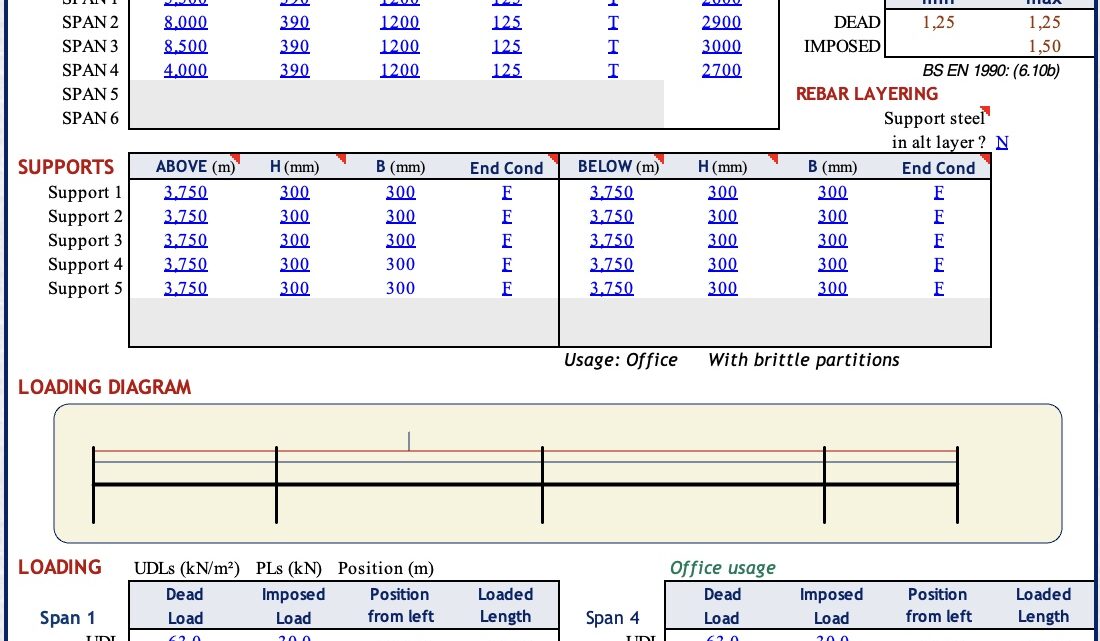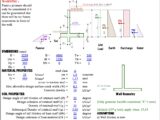
Wide Beam Analysis and Design Spreadsheet
2 August 2025Table of Contents
Wide Beam Analysis and Design Spreadsheet
In modern structural engineering, efficiency and accuracy are paramount. While beams are fundamental elements, not all are created equal. The “wide beam” presents unique challenges that demand more than just standard calculations. A meticulously crafted Wide Beam Analysis and Design Spreadsheet is no longer a luxury—it’s an indispensable tool for engineers aiming for optimal, code-compliant, and efficient designs.
This guide will explore why a specialized spreadsheet is a game-changer for wide beam projects and what features make a template truly powerful.
What Exactly is a Wide Beam? (And Why Does it Need Special Attention?)
A wide beam is a structural member whose width is significantly larger than its depth. They are often used in concrete structures for several strategic reasons:
-
Reducing Story Height: By being wider and shallower, they help minimize the overall depth of a floor system.
-
Supporting One-Way Slabs: They are perfect for providing robust support for slabs that span in a single direction.
-
Accommodating Openings: Their large width provides space to accommodate architectural or service openings without compromising structural integrity.
However, this unique geometry introduces specific design considerations that differ from conventional beams. The primary concern is ensuring that forces are distributed effectively across the beam’s entire width and that shear is handled correctly. Standard beam formulas can be insufficient, making a specialized design tool essential.
The Power of a Spreadsheet for Wide Beam Design
Moving from manual calculations to a dedicated spreadsheet unlocks a new level of engineering capability. Here’s why it’s so effective:
-
Unmatched Speed: A spreadsheet automates the complex and repetitive calculations involved in analysis and design, transforming hours of work into mere minutes.
-
Ironclad Accuracy: By embedding code-based formulas directly into the sheet, the risk of human error is virtually eliminated. This ensures every calculation is performed consistently and correctly.
-
Effortless Optimization: Want to see if a slightly wider beam with less reinforcement is more economical? A spreadsheet allows you to instantly test dozens of “what-if” scenarios. You can tweak dimensions, material strengths, and reinforcement patterns to find the most cost-effective and structurally sound solution.
-
Crystal-Clear Documentation: A well-designed spreadsheet presents all inputs, calculations, and results in a clean, organized format. This is perfect for design checks, project submissions, and archiving.
Must-Have Features of a High-Quality Wide Beam Spreadsheet
Not all spreadsheets are created equal. A truly effective tool for wide beam analysis and design should include these key features:
-
Intuitive User Interface: A clean layout with clearly marked cells for user inputs (e.g., colored backgrounds) and locked cells for formulas to prevent accidental edits.
-
Comprehensive Inputs: The ability to enter all necessary variables, including material properties (concrete compressive strength, steel yield strength), beam geometry (width, depth, span), and loading conditions (dead loads, live loads, point loads, and distributed loads).
-
Automated Structural Analysis: The spreadsheet must automatically calculate the maximum bending moments, shear forces, and reactions based on the inputs provided. Visual charts for shear and moment diagrams are a significant plus.
-
Complete Flexural Design: It should determine the required area of longitudinal steel (top and bottom bars) to resist bending moments and check against minimum and maximum reinforcement limits as per building codes.
-
Robust Shear Design: This is critical for wide beams. The tool must calculate the required size and spacing of shear stirrups (ties) to resist shear forces.
-
Specialized Wide Beam Checks: A superior spreadsheet will include specific checks mandated by codes for wide beams. This often includes requirements for transverse reinforcement (additional small-diameter bars placed perpendicular to the main reinforcement) to ensure proper load distribution and prevent premature failure.
-
Deflection Checks: Serviceability is just as important as strength. The tool must check both short-term and long-term deflection to ensure the beam will not sag excessively under load.
-
Clear “Pass/Fail” Summaries: The final output should be a concise summary that clearly indicates whether the proposed design satisfies all code requirements, providing an at-a-glance confirmation of the design’s validity.
A Simple Workflow for Success
Using a well-structured wide beam spreadsheet is a straightforward process:
-
Enter Properties: Input your material strengths and the beam’s geometric dimensions.
-
Define Loads: Specify all applicable dead and live loads across the beam’s span.
-
Review the Analysis: The spreadsheet instantly calculates the forces. Review the moment and shear diagrams to understand the beam’s behavior.
-
Check the Design: The sheet will propose the required reinforcement. Check the clear “Pass/Fail” indicators for all design criteria (flexure, shear, deflection, etc.).
-
Optimize: If needed, adjust the beam dimensions or reinforcement and instantly see the impact on the design until you achieve an optimal and compliant result.
In conclusion, a Wide Beam Analysis and Design Spreadsheet is more than just a calculation aid; it’s a comprehensive design partner. By leveraging its power, engineers can deliver safer, more economical, and highly optimized structural solutions with confidence and speed.


